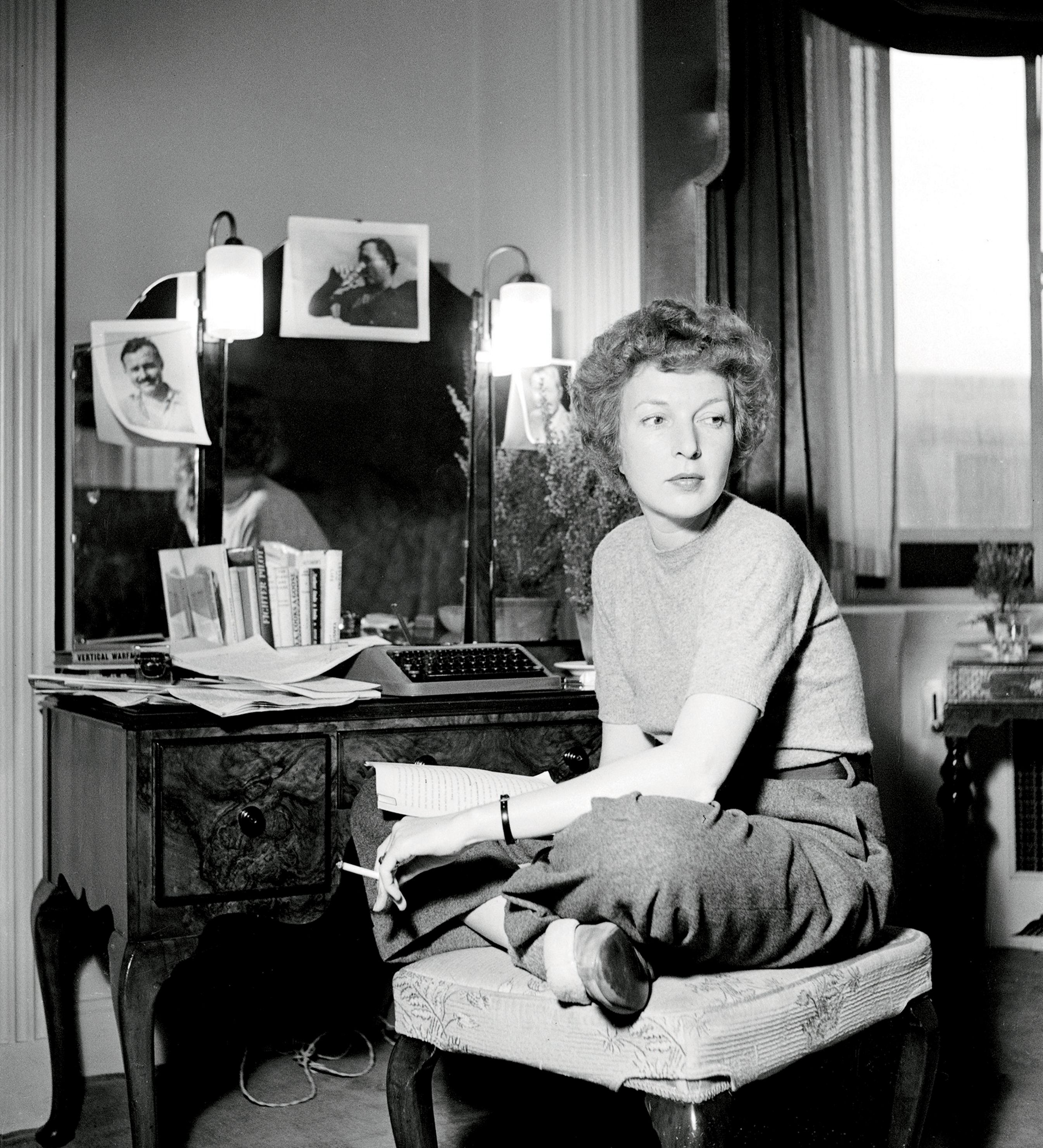Hell on Wheels (1908)
“Travel is compost for the mind.”
A song by the Swedish pop group, ABBA, revolves around lovers; their time together made more poignant by the fight for freedom raging under a star-lit sky set against the roar of canons, the retorts of gunfire. The non-fictional “Fernando” was an eminent American journalist covering a civil war with the woman who shared his bottle and bed.
In 2019, members of the English Heritage placed a blue plaque in honor of Martha Gellhorn at her former London home in Cadogan Square, Chelsea, the first to bear the dedication: war correspondent. The story of how the American writer received the singular British distinction could well have come from the pen of her acclaimed novelist husband.
From birth, her parents instilled in Martha Ellis and her three brothers a fiery independence. Her father, George Gellhorn, was an immigrant German gynecologist; her adored mother, Edna, who she described as her “true north,” was an intrepid social reformer. At age eight, Martha took her first foray in activism when she participated in a protest at the St. Louis Democratic National Convention. Edna had organized 7,000 women, clad in yellow sashes and parasols, to line Locust Street-the route delegates would travel. Her equally progressive father pulled his daughter out of a convent school when he discovered the nuns were teaching classes on female anatomy with a textbook that obscured revealing photographs. Proud of her daughter, Edna still harbored misgivings, “Martha is a law unto herself.” 
Following in her mother’s footsteps, Martha attended Bryn Mawr College; bored, she dropped out “to go everywhere, see everything, and sometimes write about it.” However, the only niche that could scratch her itch was a position as a foreign correspondent, an aspiration she achieved when she landed a job with the United Press. The periodical fired her after she reported an incident of sexual harassment by a co-worker. Undaunted, at age twenty-two, Martha alighted in Paris with two suitcases, a typewriter, and $75.00. In France, she met her first Nazi who she described as, “Scrubbed and parrot-brained,” a type she did not learn about in Bryn Mawr. In the continent, she sowed some spectacular wild oats. Her sexual sojourn involved mostly married lovers including an affair with Bertrand de Jouvenel who had slept with his Mrs. Robinson, the writer Colette, his stepmother.
In 1934, Gellhorn returned to the United States where she worked as an investigator in Franklin D. Roosevelt’s Federal Emergency Relief Administration where she chronicled the Great Depression. Her endeavors came to the attention of Eleanor Roosevelt, the person other than her mother who Martha most revered. Her travels across America led to the novella, The Trouble I’ve Seen, the title an allusion to a black spiritual. H. G. Wells provided the preface and pursued the author, “I am strongly moved to ask you to pack up come to England and to bed with me.” Martha declined. While on assignment in Idaho, Gellhorn coerced workers to break the windows of the FERA to draw attention to a crooked administrator. The tactic proved successful; the organization fired her for being a “dangerous Communist.” Empathetic, the Roosevelts invited her to live at the White House until she could get back on her feet. For two months, Gellhorn was a guest in the Lincoln Bedroom.
In Casablanca, Rick Blaine, seeing his lost love, Ilsa, bemoaned, “Of all the gin joints in all the towns in all the world, she walks into mine.” The words could well have belonged to the Nobel Prize winner, Ernest Hemingway. In 1935, either by chance or design, Martha ended up in Sloppy Joe’s Bar in Key West, Florida, where she met the acclaimed novelist. He invited the leggy blonde in the black dress to join him for drinks and was further impressed she could down glasses of Papa Dobles, a concoction of Bacardi rum and lime. Hemingway was hooked. For her part, Martha was in awe of the author of A Farewell to Arms in which the hero told a woman, “You’re brave. Nothing ever happens to the brave.” Ernest-contrary to his name- was married to his second wife Pauline-who had been the other woman in his first marriage.
When Hemingway, in his role as journalist, left to cover the Spanish Civil War, Martha followed suite and arrived in Madrid with a rucksack, $50.00, and an assignment from Collier’s Magazine. Her open sesame to the world of journalism was a letter from President Roosevelt addressed to “All American Foreign Service Officers to provide every assistance to an old friend.” In the Hotel Florida, their lovemaking took place against the bombardment of Fascist bombs. To drown out the horror, they played Chopin’s Mazurka in C Major. They had their first fight the day after when Hemingway locked her in the room with the comment he “didn’t want her mistaken for a whore de combat.”
Ernest had lived with his first wife, Hadley, in Paris, his second wife, Pauline, in America, his third wife, Martha, in Cuba. The couple married in 1940 in Wyoming (roast moose for dinner) and settled in Finca Vigía (Watchtower Farm), a retreat overlooking the hills of Havana. Her decorating touch was chintz covered chairs; she detested the animal heads Hemingway mounted on the walls, souvenirs from his 1934 African safari. On his Royal typewriter in their Cuban getaway, Hemingway wrote For Whom the Bell Tolls that bore the dedication: This book is for MARTHA GELLHORN. Hemingway had patterned the character of Maria after Martha; when the book became a movie, Gellhorn successfully suggested Ingrid Bergman for the role.
When the power literary couple were apart, Martha wrote letters to her husband filled with pet names for him and his private part that she nicknamed “Scoobie.” Despite the term of sexual endearment, she wrote a friend that in regard to sex with Ernest “is the hope it would soon be over.” Martha’s first and foremost love was her career that proved the snake in their Edenic hideaway. She tired of his Kilimanjaro sense of entitlement; he resented her pursuit of news over remaining by his side. Steaming, he told Gellhorn’s mother that he should have added to his book’s dedication to Martha, “If I can find her.” When Collier’s sent her to a London in shambles after the Blitz, he sent her a cable, “Are you a war correspondent or wife in my bed?” After Martha called in a vet to fix some of the tomcats on their property, he claimed it was her psychological desire to emasculate him.
As enraged as the bulls he chased in Pamplona, Hemingway contacted the editor of Collier’s and offered his services, aware his famous name would take precedent over his wife’s. When Martha discovered her husband’s duplicity, she was livid. Revenge was sweet when she stowed away on a hospital ship and reached the Normandy shore on D-Day; a feat that eluded Ernest as he witnessed the action through binoculars aboard a tanker on the Channel. She alighted on Omaha Beach: the sole woman amidst 160,000 men. Hemingway felt it a worst form of castration than the ones involving the tomcats. Afterwards, they met up in London’s Dorchester Hotel where a ferocious fight ended in Martha’s farewell to Ernest. She was the only one of Hemingway’s wives to walk out on him, an act he never forgave. Martha said of his rage, “Hell hath no fury like that of E. H. scorned.” Dreading posterity would merely remember her as one of Hemingway’s ex-wives his name became verboten. As she put it, “Why should I be a footnote to someone else’s life?” Even while married, Martha had strayed, once with General James Gavin, who had conducted a simultaneous affair with Marlene Dietrich.
Martha lived her mantra that love passes-work remains. She went to Dachau with the liberation troops and described it as “the circle of Hell.” She wrote of the haunting sight, “Behind the barbed wire and the electric fence the skeletons sat in the sun and searched themselves for lice. They have no age and no faces; they all look alike and like nothing you will ever see if you are lucky.” Of her nomadic existence as a foreign news correspondent, Martha stated, “I liked having no possessions, no problems, and you never knew if you were going to be alive after the next day and that was immensely interesting.” Perhaps her bravura came from her ex-husband’s quotation, “Nothing ever happens to the brave.” Not one to let age slow her down, in her 70s, she covered civil wars in Central America and reported on the US invasion of Panama, the year she turned 81.
The opposite sex and Martha were akin to a magnet and a nail, and she maintained lifelong relationships with male friends who she referred to as “trench buddies.” One of these was the acclaimed photographer Robert Capa, with whom she had experienced bombing raids in Spain and the violence that accompanied the birth of Israel. However, her love affairs, including the one with her second husband, Tom Matthews, a former editor of Time, came with an expiration date. She recalled her marriage as “nine invaluable years.” Martha’s take on holy matrimony, “For me, marriage is a terrible institution, and it should be suppressed.” Nevertheless, the union did foster a relationship with her stepson, Sandy Matthews, who she preferred over Sandy Gellhorn, who she had adopted in 1949 from an Italian orphanage. She explained she had embarked on the road of maternity-after a number of abortions-because she did not want to feel like a “dried seed pod.” The mother and son relationship was rife with tension as Martha was a lifelong doer and despaired of Sandy who had perfected the art of idleness. Eleanor Roosevelt remarked of the adult Sandy Gellhorn that he suffered from Martha’s consuming self-absorption. Her life-long love affair was with countries-and she traversed the globe with sojourns in Spain, Cuba, Mexico, England, and a passionate one with the continent of Africa.
Desirous of leaving the United States-which she considered a colonial power-she sojourned to Cuba, Italy, Mexico, and Kenya until she settled in Britain where she spent her last fifteen years shuttling between a small cottage in Wales and an apartment in London. Her home served as a salon for writers and foreign correspondents. The flat was spartan as she preferred to spend her money on her travels. In her eighties, she planned on snorkeling in the Seychelles until her cataract surgery went awry; she had the doctor professionally cursed by a Malagasy medicine man. Well into her twilight years, she continued to chain-smoke, drink, and eat whatever she damn well pleased.
Looking back on her life that was as colorful as that of a heroine in a Hemingway novel, she reflected, “I’m over privileged. I’ve had a wonderful life. I didn’t deserve it but I’ve had it.” At age 89, plagued by ovarian cancer and diminished vision that prevented her from using the manual typewriter she had spent her life documenting her inner and outer worlds, she took the same road as Hemingway and ended her life through suicide. While he had chosen a gunshot to his head, Martha ingested a cyanide capsule. Sandy Gellhorn and Sandy Matthews scattered Martha’s ashes in the River Thames so she could “continue travelling.” On her old, battered typewriter, Gellhorn had written the words that encapsulated her indomitable spirit, “I do not wish to be good. I wish to be hell on wheels, or dead.”


